 NASA Will Air Live the August 21, 2017 Total Solar Eclipse! That NASA page makes availabe what NASA's streams will be available live on the day of the eclipse. Check more details to view that remarkable event!
NASA Will Air Live the August 21, 2017 Total Solar Eclipse! That NASA page makes availabe what NASA's streams will be available live on the day of the eclipse. Check more details to view that remarkable event!
 NASA Will Air Live the August 21, 2017 Total Solar Eclipse! That NASA page makes availabe what NASA's streams will be available live on the day of the eclipse. Check more details to view that remarkable event!
NASA Will Air Live the August 21, 2017 Total Solar Eclipse! That NASA page makes availabe what NASA's streams will be available live on the day of the eclipse. Check more details to view that remarkable event!
![]() .Events .Moon .Planets .Major Events .Minor Planets, NEOs .Comets .Shooting Stars .Occultations .Sun .check more! (occultations observers are advised to check in 'Events', and to turn to such dedicated sites like the I.O.T.A). don't forget to check the weather! For the US: the NOAA . color codes: Wwd worldwide, UsA USA-Americas, EuA Europe-Africa, AsP Asia-Pacific, Chk Check for Your Zone. check the site's concept and the instructions of use
.Events .Moon .Planets .Major Events .Minor Planets, NEOs .Comets .Shooting Stars .Occultations .Sun .check more! (occultations observers are advised to check in 'Events', and to turn to such dedicated sites like the I.O.T.A). don't forget to check the weather! For the US: the NOAA . color codes: Wwd worldwide, UsA USA-Americas, EuA Europe-Africa, AsP Asia-Pacific, Chk Check for Your Zone. check the site's concept and the instructions of use
![]()
 Editor's Choice Fine Picture
Editor's Choice Fine Picture ![]() Editor's Choice Sky At
Editor's Choice Sky At ![]()
![]()
![]() Tech News
Tech News ![]() color codes: Wwd worldwide, UsA USA-Americas, EuA Europe-Africa, AsP Asia-Pacific, Chk Check for Your Zone. check the site's concept and the instructions of use
color codes: Wwd worldwide, UsA USA-Americas, EuA Europe-Africa, AsP Asia-Pacific, Chk Check for Your Zone. check the site's concept and the instructions of use
| Tweet |
.Events Seen All Month Long .Ephemerides Proper
(data from yearly ephemerides generator at Fred Espenak's NASA's eclipse website; miscellaneous data with the 'Astronomical Phenomena for The Year 2017,' a joint work by the United Kingdom Hydrographic Office and the U.S. Naval Observatory; to be found at the latter's site; all time UT except otherwise stated)
Wwd The northern hemisphere Great Winter Sky is ornating dawn worldwide this month. Fine visual and photographic opportunities. Venus is adding as Moon may come to add further!
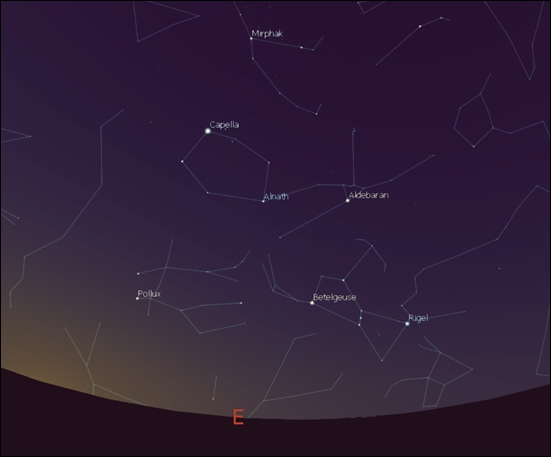 | The bright stars of the northern hemisphere Great Winter Sky are ornating dawn in August worldwide! picture site 'Amateur Astronomy' based upon Stellarium |
Wwd Fine stars of the southern hemisphere skies are ornating the whole South of the Tropics by twilight. Fine viewing and photographic opportunities as Moon may come to add!
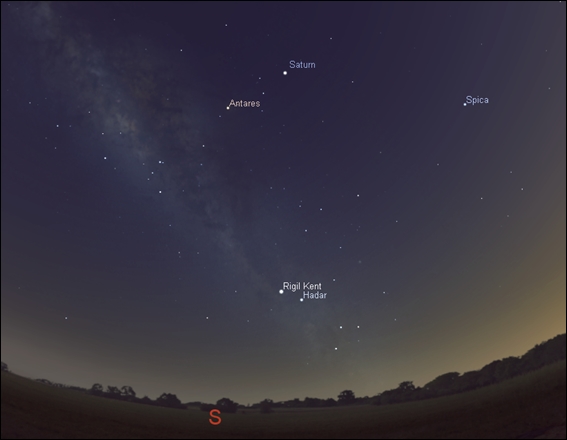 | Fine stars of the southern hemisphere skies are ornating the whole South of the Tropics by twilight picture site 'Amateur Astronomy' based upon Stellarium |
1 Wwd The Perseids, one of the most important meteor showers of the year, are usually active Jul. 17-Aug. 24 with their peak usually next month on Aug. 11-12. Perseids are one of the year's most important meteor shower more at the date of the peak
2 (1)UsA Waxing gibbous Moon, by all latitudes, is close to Saturn tonight
2 (2) Wwd Moon is at its apogee at 17:55 UT (distances non available)
3 EuA AsP Waxing gibbous Moon, at all latitudes, is close to Saturn tonight
4 Wwd Moon reaches a southernmost declination at 18:17 UT
7 Wwd The second and last lunar eclipse in 2017 occurs today, the partial lunar eclipse of August 7th, 2017. more
8 Wwd Moon is at a descending node at 10:56 UT
9 Wwd Neptune is occulted by Moon by 23:00 UT! check more at such sites like "The International Occultation Timing Association" (I.O.T.A.); check too below
11 Wwd Perseids shooting stars usually are peaking on Aug. 11-12 more back
16 Wwd Aldebaran, the bright star to constellation Taurus, the Bull is occulted by Moon by 07:00 UT! check more at such sites like "The International Occultation Timing Association" (I.O.T.A.); check too below
17 Wwd Moon is at its perigee at 13:14 UT (distances non available)
18 (1) Wwd Tomorrow morning by dawn very last crescent, by all latitudes, will be seen close to Venus Fine visual and photographic opportunities!
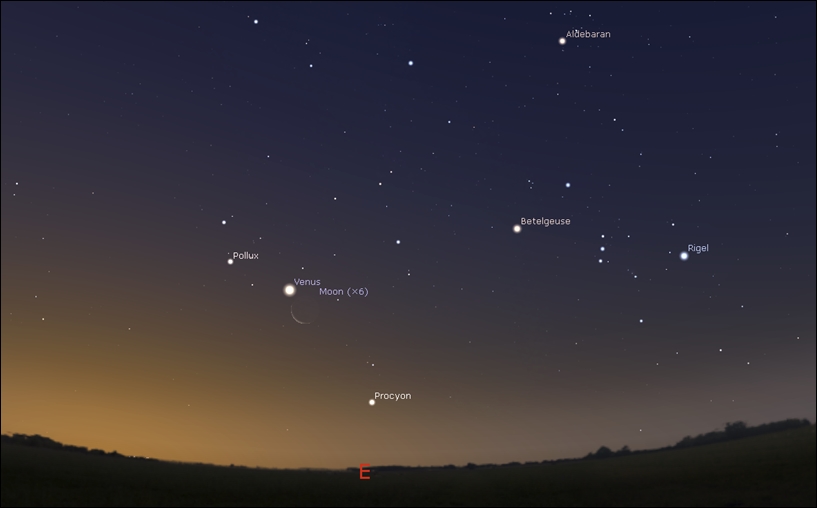 | Moon by dawn, is close to Venus! Fine! picture site 'Amateur Astronomy' based upon Stellarium |
18 (2) Wwd Moon reaches a northernmost declination at 06:50 UT
21 (1) Wwd The last solar eclipse -- and last major astronomical event -- of that year, occurs today. It is a total solar eclispe, the total solar eclipse of August 21st, 2017. more
21 (2) Wwd Moon is at a ascending node at 10:34 UT
25 (1) Wwd First crescent, at all latitudes, is close to Jupiter and Spica in the western twilight! Fine visual and photographic opportunities!
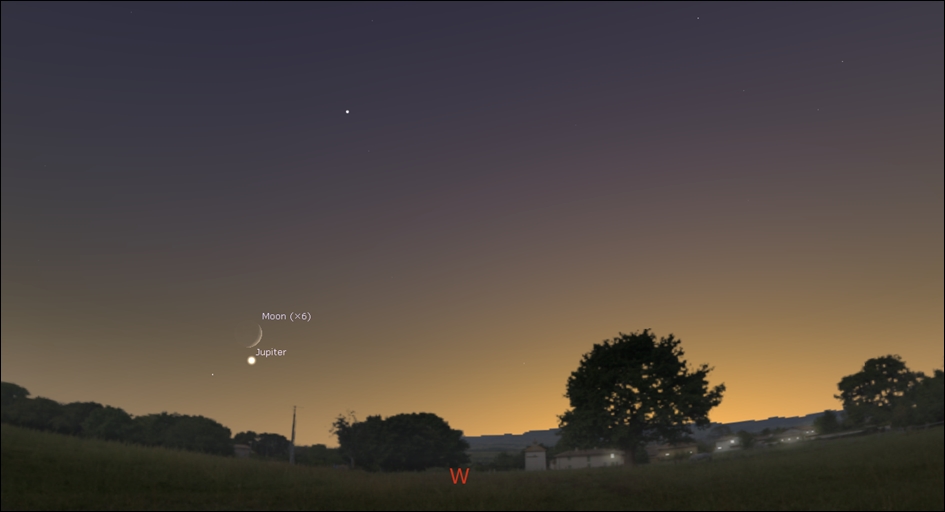 | Moon close to Jupiter and Spica! picture site 'Amateur Astronomy' based upon Stellarium |
25 (2) Wwd Alpha Aurigids are usually active Aug. 25-Sept. 5-8 with their peak usually on Sep. 1. more
30 (1) Wwd First quartered Moon, by all latitudes, is close to Saturn tonight
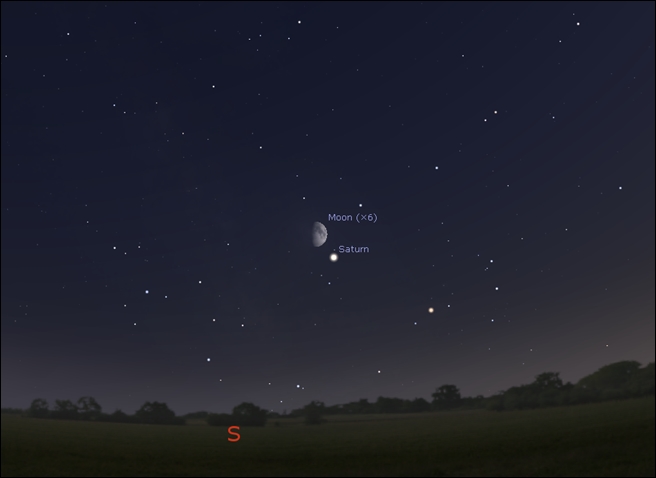 | Moon close to Saturn! picture site 'Amateur Astronomy' based upon Stellarium |
30 (2) Wwd Moon is at its apogee at 11:25 UT (distances non available)
Occultations observers are advised to turn to such dedicated sites like the I.O.T.A as they may also check below at our Occultation section
Full Moon is on August 7th, at 18:11 UT
Last Quarter is on August 15th, at 01:15 UT
New Moon is on August 21st, at 18:30 UT
First Quarter is on August 29th, at 08:13 UT
(source: NASA Reference Publication 1349, Twelve Year Planetary Ephemeris: 1995 - 2006 by Fred Espenak)
Mercury is reaching a inferior conjunction on August 26th, by 20:32. Where already available last month like a evening star -- at the Tropics and the southern hemisphere that is -- Mercury will slowly tend to the horizon all month long
Venus keeps a fine morning star worldwide. Venus is somewhat lower in the southern hemisphere
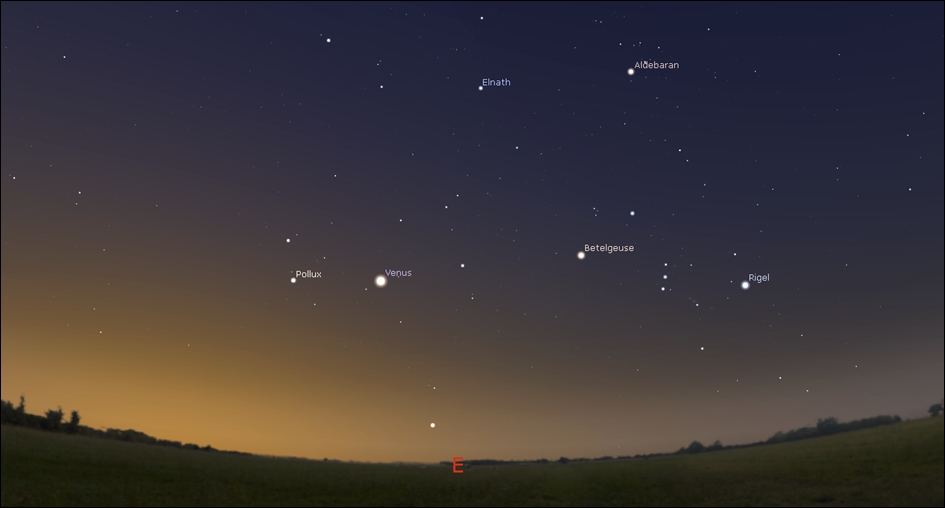 | Venus keeps a fine morning star, with the sky filled by the great winter sky of the northern hemisphere! picture site 'Amateur Astronomy' based upon Stellarium |
Mars, after its by-yearly conjunction last month, is observable nowhere worldwide
Jupiter is now on the horizon, before West, in the northern hemisphere by 10:30 p.m. local time. The gas giant has just set at the Tropics or the southern hemisphere by that same time. Jupiter is a fine evening star worldwide and seen close to Spica, the bright star to constellation Virgo, the Virgin
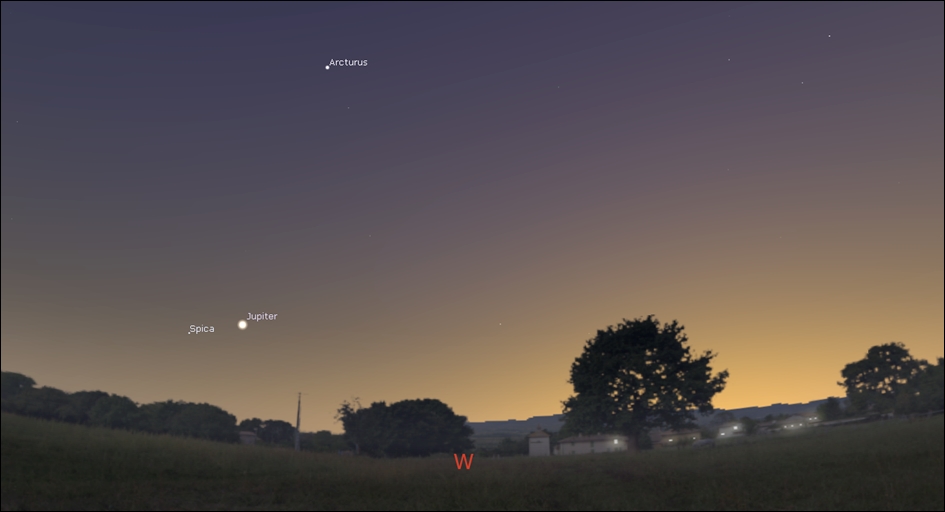 | Jupiter is a fine evening star as Spica, the bright star to Virgo, the Virgin, is close! picture site 'Amateur Astronomy' based upon Stellarium |
Saturn is high between South and southwest by 10:30 local time in the northern hemisphere, southwest very high at the Tropics by that time and West, very high, in the southern hemisphere. A ring maximum aperture is reached in 2017
Uranus is now rising by 11:10 p.m. in the northern hemisphere, 10:45 p.m. at the Tropics, and 11:12 p.m. in the southern hemisphere
Neptune Tending to its Best! is to reach its year's best next month. Neptune in the northern hemisphere, is already risen, between East and southeast, by 10:30 p.m. local time. By that time the faraway world is high and East at the Tropics and same, somewhat more distant from East, in the southern hemisphere
 | Neptune closing its best! picture site 'Amateur Astronomy' based upon Celestia |
Pluto Faraway World Still At its Best!, after its year's best last month, keeps well observable. It lies before South, high, in the northern hemisphere, very high and South at the Tropics, and at the zenith in the southern hemisphere (according to the International Astronomical Union (IAU) since 2006, Pluto is not considered a planet anymore, but categorized like a dwarf planet instead along with Ceres, Eris, Makemake, and Haumea, and the prototype of a new category of 'trans-Neptunian', 'Pluto-class' objects)
The Partial Lunar Eclipse of August 7th, 2017
The Total Solar Eclipse of August 21st, 2017
That second and last lunar eclipse for that year is partial lunar eclipse, the partial lunar eclipse of August 7th, 2017. The whole of the eclipse is observable from central Siberia, the Middle East and the easternmost areas of Africa to China, Southeast Asia and the western two thirds of Australia. Either side of it, observers will either have the eclipse already encours by moonrise or the eclipse interrupted by moonset. check a page dedicated to that event
The last solar eclipse -- and last major astronomical event -- for that year, is a total solar eclispe, the total solar eclipse of August 21st, 2017. The total solar eclipse of August 21st, 2017 is occurring from in the northern central Pacific ocean down to the central eastern Atlantic ocean. In the U.S.A., the total solar eclipse of August 21st, 2017 is one of the most anticipated astronomical events in decades as it is the first total eclipse visible from America’s lower 48 states in over 38 years (the last one had occurred in 1979). A broader area is concerned with a partial eclipse. check a page dedicated to that event
| CAUTION! OBSERVING A SUN ECLIPSE IS DANGEROUS AND MAY CAUSE IRREVERSIBLE EYE DAMAGE, UP TO BLINDNESS, ANNULAR AND PARTIAL ECLIPSES INCLUDED! Observing a Sun eclipse necessitates DEDICATED SAFE TECHNIQUES! |
Minor planets are those biggest asteroids in the Asteroid Belt which may be easily observed by amateurs from the Earth, namely Ceres, Pallas, Juno, and Vesta (due to the new categorization by the International Astronomical Union (IAU) by 2006, Ceres belongs to the 5 dwarf planets in the solar system with Pluto, Eris, Makemake, and Haumea). check data and charts at our section Minor Planets on the yearly Calendar page as our tutorial 'Asteroids and Asteroid Hunting' is of help too. Any remarkable event linked to a minor planet may have a notice here below
Some small asteroids dubbed Near-Earth Objects (NEOs) are regularly making close approaches at Earth. People interested in such close approaches may obtain recent and upcoming data at NASA site Near-Earth Object Program (their section "Close Approaches"). Date, miss distance in AU or Lunar Distance (LD), estimated diameter, and relative velocity are available. For further observational purposes, check at the Near-Earth Object Program ephemeris Generator. For more about NEOs see tutorial "
Once every time, the solar system treats us with a remarkable comet, a eery view spanning up to thirty degrees of sky! Most of the time however comets are the domain of dedicated observers as mostly weak and, at the most, hovering at the limit of the naked-eye visibility. A good site to get information about current such comets is the British Astronomical Association Comet Section page or also the Weekly Information about Bright Comets page (which often points to comets close to the visual magnitude). Our 'Comets and Comet Hunting' tutorial will also be helpful. Remarkable comets otherwise usually will be presented below!
->of note: dates of swarms and peaks as given below are the average ones. More refined dates may be given in the Ephemerids section
->note: shooting stars afficionados will be aware of checking Moon at the dates of the showers
for more about the meteor showers of this month, for possible other meteor showers for this month, and for more about shooting stars, generally, see our tutorial "Shooting Stars"
Each month, Moon occults some relatively bright stars, that is the Moon, beginning either with its bright or its dark visible face, is passing in front of a star. This is called an occultation. The Pleiades, on the other hand, due to their position near the eclipic, are often occulted by Moon too. Some planets, at last, along the year, may be occulted by Moon or they themselves, or their satellites, may be seen too occulting a star. The asteroids too may occult stars. Yearly lists of such phenomenons are to be found at Sky & Telescope/SkyTonight.com, either in their newsstand issues or at their site, as a list of occultations of most brilliant stars, the planets and the Pleiades are available at the I.O.T.A site (I.O.T.A. stands for "The International Occultation Timing Association"). Most notable occultations are signaled below
Neptune back is occulted by Moon on August 9th by 23:00 UT! The show is available for most of Antarctica, Kerguelen Is., W. tip of Australia. check more at such sites like "The International Occultation Timing Association" (I.O.T.A.)
Aldebaran back, the bright star to constellation Taurus, the Bull is occulted by Moon on August 16th by 07:00 UT! The show is available for the N. tip of S. America, Caribbean, northernmost Africa, Europe, Middle East, W. Asia. check more at such sites like "The International Occultation Timing Association" (I.O.T.A.)
check on this site for more about occultations, theoretically
| CAUTION! OBSERVING THE SUN IS DANGEROUS AND REQUIRES DEDICATED SAFE TECHNIQUES! |